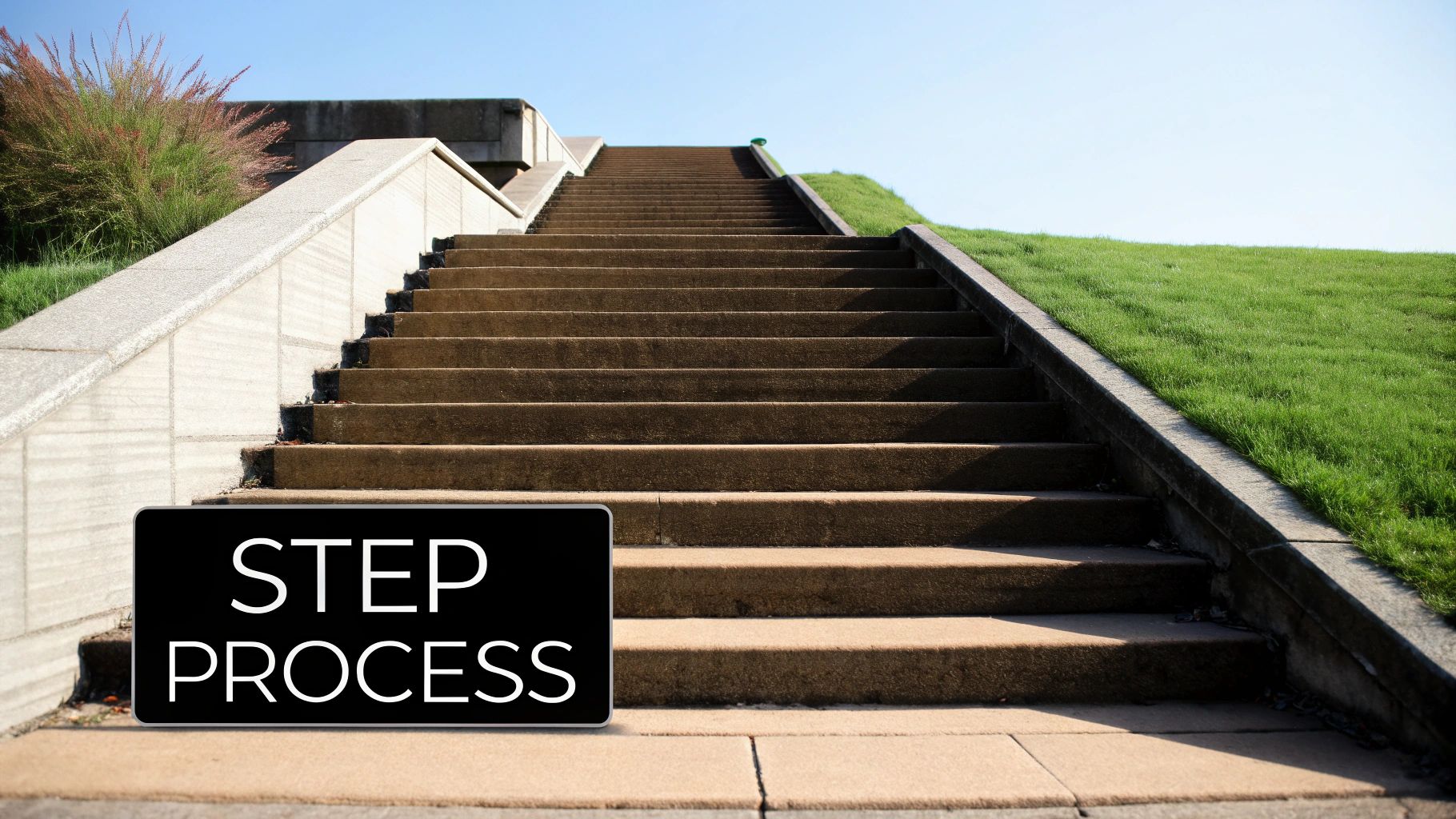The Science Behind Effective Progressive Discipline

Progressive discipline policies are more than just a series of escalating steps. They offer a structured framework to address and correct employee misconduct while also focusing on preserving a positive employer-employee relationship. It's not about punishment; it's about guidance and growth. Understanding the psychology behind this approach is key for HR professionals who want to cultivate a fairer, more productive work environment.
The Psychology of Corrective Action
Effective progressive discipline rests on a few core psychological principles. Clarity and consistency are essential. Employees thrive when expectations are clear and the consequences of not meeting them are well-defined. This transparency builds trust and promotes accountability.
Providing opportunities for feedback and dialogue is also critical. This two-way communication allows employees to share their perspective, understand the impact of their actions, and contribute to finding solutions. It empowers them to become active participants in their own improvement.
Finally, an emphasis on growth and development is paramount. When the focus shifts from punishment to improvement, employees become more motivated to take ownership of their actions and strive for positive change.
Fairness and Consistency: The Foundation of Trust
Progressive discipline policies are vital for maintaining fairness and consistency across an organization. A startling 61% of companies lack formal systems for reporting misbehavior, leaving them vulnerable to legal risks. This highlights the importance of a structured approach like progressive discipline, ensuring that similar offenses are handled equitably.
This lack of reporting mechanisms underscores the need for robust policies to preempt legal issues. Within the European Union, organizations with clear disciplinary procedures have seen 40% fewer legal challenges compared to those without such frameworks. Progressive discipline fosters a transparent and equitable environment, offering employees a chance to explain their actions while reinforcing accountability. For a deeper dive into these statistics, visit the AIHR blog.
From Dread to Dialogue: Transforming Disciplinary Conversations
Traditional disciplinary conversations can be tense and unproductive. But by shifting the perspective from blame to problem-solving, these interactions can become valuable opportunities for growth. Rather than simply reprimanding an employee for repeated tardiness, a manager can initiate a conversation to understand the underlying reasons and collaborate on solutions. Perhaps childcare or commuting challenges are at play. By addressing the root cause, the manager not only helps the employee improve punctuality but also strengthens their relationship through empathy and understanding.
This approach avoids rigid, overly standardized systems, minimizing any negative impact on workplace culture. It requires managers to be adept at active listening, demonstrating empathy, and delivering constructive feedback.
Mastering the Four-Stage Discipline Framework

A well-defined progressive discipline policy offers a structured, step-by-step process for addressing employee performance or conduct issues. This framework isn't about punishment; it's about growth. It's a system designed to provide opportunities for improvement, ensure fairness, and protect both the employee and the organization. This structured approach, including stages like verbal warnings, written warnings, and suspension before termination, is key. It ensures employees have a chance to correct their course.
In the U.S., 4.5% of employees faced disciplinary action in 2022, illustrating how common these processes are. Documentation is vital for maintaining fairness and legal compliance. This helps organizations adhere to policies and legal requirements, preventing legal challenges. In the UK, only 3% of employees received disciplinary action in 2021, highlighting how practices can vary. For more detailed statistics, see diversity.social/disciplinary-actions/.
Understanding the Stages of Progressive Discipline
The four stages of progressive discipline typically offer escalating levels of intervention:
-
Verbal Warning: This initial stage addresses minor infractions or first-time offenses. It's a private conversation between the manager and the employee, outlining the issue and expectations for improvement. Even though informal, documenting this conversation is crucial for establishing a record. Providing effective feedback is essential in this process. For actionable strategies, explore techniques on constructive feedback.
-
Written Warning: If the behavior continues or for more serious first-time offenses, a written warning follows. This formal document details the infraction, previous warnings (if any), expectations for improvement, and potential consequences of continued misconduct. This serves as a concrete reminder of the issue and a clear roadmap for corrective action.
-
Suspension: When problems persist despite verbal and written warnings, suspension—with or without pay—may be necessary. This temporary removal from the workplace offers reflection time for both the employee and the organization. It can also allow for further investigation.
-
Termination: This final stage is reserved for serious offenses or when previous interventions have failed. Termination should always be handled carefully, ensuring adherence to all legal requirements and company policies.
To understand the differences between these stages better, let's review the following table.
Progressive Discipline Stages Comparison
This table compares the four standard stages of progressive discipline, highlighting key actions, documentation requirements, and typical timeframes for each stage.
| Discipline Stage | Key Actions | Documentation Required | Typical Timeframe | Employee Rights |
|---|---|---|---|---|
| Verbal Warning | Private conversation, outline issue & expectations | Informal notes of the conversation | Immediate – 1 week | To understand the issue and respond to the feedback |
| Written Warning | Formal letter, details of infraction & expectations | Formal letter signed by manager and employee | Varies | To formally respond to the warning and provide explanation |
| Suspension | Temporary removal from work | Formal documentation of suspension terms & reasons | Varies | To understand the terms of the suspension and appeal |
| Termination | Permanent severance of employment | Formal termination letter outlining reasons & final pay | Immediate | To understand the reasons for termination and appeal |
As we can see from the table above, progressive discipline provides a framework that balances corrective action with opportunities for employees to improve. The increasing formality of documentation at each stage underlines the seriousness of the process.
Balancing Consistency and Personalization
While consistency is critical in applying progressive discipline, recognizing individual circumstances is equally important. Consider factors contributing to the performance or conduct issue, like personal challenges, lack of training, or unclear expectations. An employee consistently missing deadlines might be struggling with a heavy workload or lacking resources. Addressing the root cause is often more effective than simply applying discipline.
Effective Implementation: A Key to Success
A progressive discipline policy’s success hinges on effective implementation. This requires clear communication of the policy to all employees, thorough manager training on consistent and fair application, and meticulous documentation at each stage. Regular review and updates to the policy are essential to ensure its continued effectiveness and relevance. This builds trust, reinforces accountability, and fosters a fairer, more productive workplace.
Navigating the Legal Landscape of Workplace Discipline
A well-crafted progressive discipline policy is more than just a set of rules. It's a shield, protecting your company and creating a fairer environment for everyone. Understanding employment law is key to building a policy that truly works, preventing expensive legal battles and nurturing a more balanced workplace.
Legal Compliance: A Non-Negotiable Aspect
Employment laws vary widely, so staying up-to-date is paramount. Anti-discrimination laws, for instance, are especially important when making disciplinary decisions. Remember, you can't discipline someone based on protected characteristics like race, religion, or gender. Disciplinary actions must be rooted in objective performance or conduct issues, never personal biases.
Documentation: Your First Line of Defense
Thorough documentation is your best protection. Every single stage of the progressive discipline process—from initial conversations to final decisions—needs to be documented meticulously. Include the date, time, the specific issue, the employee’s response, and any agreed-upon steps. This record provides a crystal-clear timeline, showing consistent and fair application of your policy. This documentation is vital if you need to defend against legal challenges.
Special Considerations: Navigating Complexities
Some employees require particular legal consideration. Union members often have rights outlined in their collective bargaining agreements that directly affect disciplinary processes. Disciplining employees with disabilities requires careful adherence to the Americans with Disabilities Act (ADA) to guarantee reasonable accommodations are provided. And addressing issues within protected classes demands extra vigilance to avoid even the appearance of discrimination.
Building a Legally Sound Policy
Creating a truly effective and legally compliant progressive discipline policy demands a multifaceted strategy:
- Policy Review: Regularly review your policy to ensure it remains aligned with the latest laws and best practices.
- Legal Counsel: Partner with a legal expert specializing in employment law to ensure your policy is rock-solid.
- Training: Offer comprehensive training to your managers and HR team on legal requirements and proper documentation procedures.
- Transparency: Openly communicate the policy to all employees so everyone understands their rights and responsibilities.
Practical Application: Case Studies and Examples
Real-world scenarios illustrate the complexities of progressive discipline. Imagine an employee with documented anxiety who receives a written warning for frequent absences. While the absences disrupt operations, the employer must consider reasonable accommodations under the ADA. Perhaps a flexible work arrangement or access to mental health resources could address the root issue while respecting company policy. This balanced approach ensures compliance and supports employee well-being. Consider another case: an employee files a harassment complaint and subsequently receives a performance warning. The timing raises red flags. A thorough investigation is crucial to ascertain whether the warning is legitimate or if discriminatory practices are at play.
Through diligent attention to legal considerations, organizations can build progressive discipline policies that are both fair and legally sound, promoting a more equitable and productive work environment for all.
When Progressive Discipline Falls Short: Honest Critique

While a progressive discipline policy offers structure for addressing misconduct, it isn’t always the perfect solution. This section explores the potential downsides of traditional progressive discipline and considers alternative approaches. This balanced perspective helps HR professionals build truly effective and equitable workplaces.
The Psychological Impact of Rigid Systems
Traditional progressive discipline aims for fairness but can sometimes have unintended consequences. Rigidly following a standardized process can foster fear, damaging open communication and trust between employees and management. This can decrease productivity and stifle innovation, as employees become overly cautious.
For example, in specialized or creative roles, a rigid progressive discipline policy might discourage risk-taking and experimentation. Even a minor mistake on a creative project could lead to a formal warning, hindering future innovation.
Power Imbalances and Documentation Burdens
Progressive discipline can also reinforce power imbalances. The process can be intimidating, especially if employees perceive a lack of fairness or transparency. The required documentation, while legally important, can burden managers, taking time away from strategic work.
Addressing Underlying Issues
Sometimes, misconduct is a symptom of a larger problem, like inadequate training or unrealistic expectations. Focusing solely on individual discipline without addressing these underlying issues is ineffective. It's like treating the symptoms while ignoring the disease. There are valid criticisms of the progressive discipline policy. Learn more about why progressive discipline can be flawed.
Despite its benefits, some argue that progressive discipline is outdated and ineffective in certain situations. Using it as a threat can create a fearful environment, hindering productivity and decision-making. This fear can make employees overly cautious, impacting innovation and performance.
Furthermore, the policy may not address systemic flaws that contribute to employee errors. For instance, if a mistake stems from a flawed procedure, progressive discipline unfairly penalizes the employee instead of fixing the root cause. This has led some to advocate for restorative practices that focus on repairing relationships and addressing root causes, rather than just punishment.
When Progressive Discipline Is Counterproductive
Progressive discipline isn’t always the right approach. Serious misconduct, like theft or violence, might warrant immediate termination, not a series of warnings. Subtle but persistent microaggressions, while harmful, can be difficult to address through traditional frameworks. These situations require more nuanced approaches. One alternative is restorative practices, which prioritize dialogue, understanding, and repairing harm.
Moving Beyond Traditional Approaches
Recognizing the limitations of traditional progressive discipline policies allows for more innovative solutions. By incorporating coaching, mentorship, and restorative practices, organizations can build a culture of accountability focused on growth, not just punishment. This shift prioritizes collaboration and understanding over blame. These alternatives can be particularly useful in specialized fields, creative settings, and situations where traditional methods are ineffective.
Building Your Progressive Discipline Masterplan

A successful progressive discipline policy is more than just a document. It's a thoughtfully designed plan that works in harmony with your company culture and legal responsibilities. This section provides a practical guide for developing and implementing such a policy, helping you turn concepts into real-world actions for a more productive and fair workplace.
Defining Severity Levels and Expectations
The cornerstone of any effective progressive discipline policy is clearly defining unacceptable behaviors and their corresponding severity. This ensures consistent application and helps employees understand the potential repercussions of their actions.
For example, occasional tardiness might be a low-level offense, while insubordination or harassment are high-level offenses. This categorization allows for appropriate disciplinary actions at each level.
Clear expectations for employee conduct are also essential. Detail acceptable workplace behavior in your employee handbook and other communications. This proactive approach minimizes confusion and sets a clear standard for everyone.
Creating Equitable Consequences
After defining severity levels, establish fair consequences that align with each level of misconduct. This guarantees fairness and proportionality in disciplinary actions. A low-level offense, like occasional tardiness, might result in a verbal warning, while repeated tardiness could lead to a written warning. Serious offenses, like harassment, may justify immediate suspension or termination.
Consider offering opportunities for remediation and improvement, especially for less serious offenses. This might include further training, mentorship, or performance improvement plans. This shows your commitment to growth and development, not just punishment.
Tailoring Your Policy to Your Unique Culture
A generic approach to progressive discipline is rarely effective. Your policy must reflect your organization’s unique needs and culture. A fast-paced startup might have a different approach to attendance than a large corporation. Consider the nuances of your industry, company size, and workforce demographics.
For instance, if your company values open communication, build that into your progressive discipline process. Encourage dialogue and feedback at each stage.
Training Managers for Effective Implementation
Even the best policy is ineffective without proper implementation. Managers need thorough training on applying the policy fairly and consistently. This includes understanding the stages of discipline, documentation requirements, and how to have difficult conversations.
Role-playing exercises and case studies can be valuable training tools, allowing managers to practice applying the policy in realistic scenarios. This helps them navigate complex disciplinary situations with confidence.
Communicating Your Progressive Discipline Policy
Transparency is key. Ensure all employees understand the policy, its purpose, and its application. This promotes accountability and builds trust in the process.
Consider workshops or presentations to introduce the policy, providing opportunities for questions and feedback. Make the policy readily available, perhaps through your company intranet or employee handbook.
Implementation and Evaluation
Establish a clear implementation timeline and key metrics to evaluate effectiveness. Track the number of disciplinary actions, the types of offenses, and the overall impact on employee performance.
Regularly review and update your progressive discipline policy to ensure it remains relevant and effective. Feedback from managers and employees offers valuable insights for improvement. This continuous improvement process ensures your policy stays a powerful tool for building a fair and productive workplace.
To guide you in building a thorough policy, the table below provides a detailed breakdown of key elements to include:
This table outlines the essential elements to include in a comprehensive progressive discipline policy document, along with examples and implementation notes for each element.
| Policy Element | Purpose | Example Language | Implementation Notes |
|---|---|---|---|
| Purpose Statement | Explains the policy's goals and objectives. | "This policy aims to provide a fair and consistent framework for addressing performance and conduct issues." | Ensure alignment with company values and legal requirements. |
| Scope | Defines who the policy applies to. | "This policy applies to all employees of [Company Name]." | Clearly specify which employees are covered by the policy. |
| Definitions | Clarifies key terms used in the policy. | "Insubordination is defined as…" | Provide clear and concise definitions to avoid ambiguity. |
| Stages of Discipline | Outlines the steps involved in the progressive discipline process. | "The stages of discipline are: verbal warning, written warning, suspension, and termination." | Describe each stage in detail, including the typical consequences. |
| Documentation | Specifies documentation requirements at each stage. | "All disciplinary actions must be documented in writing." | Outline specific documentation procedures and storage requirements. |
| Appeals Process | Explains how employees can appeal disciplinary actions. | "Employees may appeal disciplinary actions through their immediate supervisor…" | Provide a clear and accessible appeals process to ensure fairness. |
| Confidentiality | Addresses the confidentiality of disciplinary information. | "All disciplinary information will be treated as confidential…" | Outline procedures for maintaining confidentiality. |
| Training | Describes training requirements for managers and supervisors. | "All managers will receive training on the progressive discipline policy." | Ensure managers and supervisors receive adequate training on policy implementation. |
| Review and Updates | Specifies how often the policy will be reviewed and updated. | "This policy will be reviewed and updated annually." | Establish a regular review process to keep the policy current. |
By carefully considering these elements and crafting a well-defined plan, you can leverage progressive discipline to cultivate a more productive and respectful work environment for everyone.
Beyond Traditional Discipline: Innovation in Accountability
The modern workplace calls for a fresh perspective on accountability. While progressive discipline policies offer a structured approach, they sometimes fall short in today's dynamic environment. This section explores innovative alternatives, complementing or even replacing conventional methods to build stronger relationships and address the root causes of misconduct.
Coaching-Centered Approaches: Guiding Towards Growth
A coaching-centered approach prioritizes development over punishment. Instead of issuing warnings, managers become coaches, guiding employees toward improvement. This involves regular feedback, mentorship, and opportunities for skill development. It cultivates a culture of learning and empowers employees to take ownership. For instance, rather than receiving a written warning after a miscommunication, an employee struggling with communication could benefit from coaching sessions focused on active listening and clear expression.
Restorative Practices: Repairing Workplace Relationships
Restorative practices focus on repairing harm and rebuilding relationships after misconduct. Facilitated dialogues between involved individuals help everyone understand the impact of the behavior and find collaborative solutions. This approach builds empathy and accountability, leading to a more harmonious and supportive work environment. Imagine a conflict between two team members. A restorative approach would involve a mediated conversation where they discuss the conflict's impact and work together to find a positive path forward.
Performance Partnership Models: Shared Ownership of Success
Performance partnership models emphasize shared accountability between managers and employees. This includes collaborative goal setting, regular check-ins, and open communication about performance expectations. This fosters a sense of ownership and shared responsibility for success. Instead of dictating goals, managers and employees work together to establish objectives, identify potential obstacles, and create a plan for achievement.
Implementing Innovative Discipline Strategies
Transitioning to these innovative frameworks requires careful planning and execution. Consider these steps:
- Assessing your current culture: Is your organization ready to move away from traditional disciplinary approaches?
- Pilot programs: Test new strategies with small groups to gather data and refine your approach before a full-scale launch.
- Training managers: Equip managers with the skills to implement coaching, restorative practices, or performance partnership models.
- Communicating clearly: Explain the changes to employees, highlighting the benefits and addressing any concerns.
Measuring Success and Overcoming Challenges
Measuring the success of these strategies requires different metrics than traditional approaches. Focus on outcomes like these:
- Improved employee engagement: Are employees more motivated and committed?
- Reduced conflict: Have workplace disagreements and tensions decreased?
- Increased productivity: Are teams performing more effectively and achieving their goals?
Implementation challenges might include resistance to change, especially from managers accustomed to traditional methods. Addressing these challenges involves clear communication, ongoing training, and showcasing the positive impact of the new approaches through data and success stories.
Ready to transform your approach to accountability and build a more positive and productive environment? The Global Human Resource Institute offers programs and certifications to equip HR professionals with the skills needed for modern workplace challenges. Visit their website to learn more and empower your HR team with the tools for success.




0 Comments